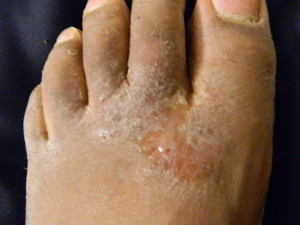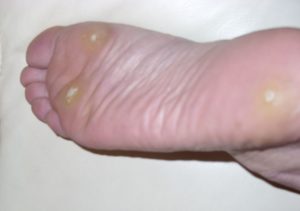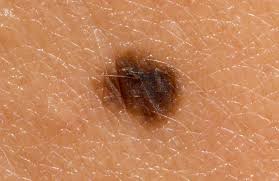Podiatrist’s Guide to Melanoma and Common Skin & Nail Conditions and Common Skin & Nail Conditions
January 9 2024
Excited to share our latest article from Dr. Chapman focusing on foot health essentials. Whether you’re a fitness enthusiast or a corporate professional, taking care of your feet is a corporate professional, taking care of your feet is step towards overall well-being.
In this article, we delve into:
Understanding Melanoma on the feet: Why regular self-checks are crucial.
Common Foot Skin Conditions: From athlete’s foot to ingrown toenails – prevention and treatment tips.
When to Seek Professional Help: The importance of regular podiatrist check-ups.
Dive into the details and boost your foot health knowledge:
https://www.naplespodiatrist.com/
Let’s start a conversation below! Share your favorite foot care tips or any questions you may have. Let’s put our best foot forward together! #FootHealth #MelanomaAwareness #Podiatry #WellnessWednesday #ArticleAlert #HealthyLiving
Our feet, the unsung heroes of daily life, are susceptible to a range of skin issues, some of which can be potentially life-threatening.
Podiatrists, specialists in foot health, play a pivotal role in diagnosing and managing various foot skin conditions. In this comprehensive article, we will explore common foot skin issues, focusing on the crucial inclusion of melanoma, a severe form of skin cancer, and the importance of recognizing its ABCDE’s for early detection.
1. Athlete’s Foot (Tinea Pedis)
Athlete’s foot, scientifically known as Tinea Pedis, is a prevalent fungal infection that often thrives in warm and moist environments. This condition primarily affects the spaces between the toes, causing itching, redness, and peeling of the skin. It is crucial to keep the feet clean and dry, wear breathable footwear, and consider antifungal medications or tropical creams as recommended by a podiatrist.

2. Plantar Warts
Plantar warts, caused by the human papillomavirus (HPV), can be painful growths on the soles of the feet. These warts often appear as small, rough lesions with tiny black dots. While some plantar warts may resolve on their own, podiatrists may suggest various treatments such as freezing, laser therapy, or surgical removal for persistent or painful cases.

Blisters can result from excessive friction or ill-fitting shoes, causing fluid-filled pockets on the skin. Podiatrists advise on proper footwear choices, blister prevention strategies, and may provide treatment for existing blisters, including sterile draining and protective dressings to prevent infection.
4. Fungal Nail infection (Onychomycosis):
Fungal nail infections, or onychomycosis, affect toenails due to dermatophytes thriving in warm, moist conditions. Symptoms include discoloration, thickening, and brittleness, potentially leading to nail separation. Podiatrists tailor treatments based on severity. Tropical medications, like antifungal creams, address milder cases, while oral antifungal creams, address milder cases, while oral antifungal medications or laser therapy target more stubborn infections. Preventive measures, such as keeping feet dry and wearing breathable footwear, are crucial. Regular podiatric consultations ensure effective monitoring, timely intervention and prevent recurrent infections, preserving toenail health and appearance.
5. Corns and Calluses:
Corns and calluses, arising from repetitive friction and pressure, commonly affect the feet. Corns, small hardened bumps on toes or sides, and calluses, larger thickened areas on the soles, can cause discomfort.
Podiatrists, experts in foot health, address these issues through debridement to reduce thickness and offer guidance on proper footwear. Ill-fitting shoes contribute, prompting podiatrists to recommend adjustments for pressure relief. Addressing underlying structural issues, such as foot mechanics abnormalities, is essential for preventing recurrence.
Podiatrists provide comprehensive care, emphasizing foot hygiene, enabling individuals to manage and prevent these common foot issues for sustained comfort and mobility.
6. Eczema and Psoriasis:
Eczema and psoriasis on the feet present unique challenges, with redness, itching, and inflammation characterizing eczema, while psoriasis manifests as thick, scaly patches. These conditions impact the soles, heels, and sides, causing discomfort and limiting mobility. Podiatrists collaborate closely with dermatologists, creating effective management plans that often involve topical treatments like corticosteroids and emollients to alleviate symptoms and maintain skin hydration. Podiatrists also guide lifestyle adjustments and foot care practices to minimize flare-ups. Regular monitoring ensures timely interventions for fluctuating conditions, contributing to overall well-being by addressing the specific nuances of eczema and psoriasis on the feet.
7. Melanoma:
Melanoma is a severe form of skin cancer that can develop on the feet. It is crucial to be aware of the ABCDE’s for early detection.

A – Asymmetry: One half of the mole differs from the other.
B: Border Irregularity: Edges may be notched or blurred.
C: Color Variation: Melanomas often display diverse colors.
D: Diameter: Typically larger than 6 millimeters
E: Evolution: Any changes in size, shape, color, or elevation should be monitored.
Podiatrists pay a pivotal role in melanoma awareness through regular foot examinations, where they scrutinize moles, discolorations, or irregularities. Early detection is paramount, and if suspicious  lesions are identified, podiatrists promptly refer patients to dermatologists or oncologists for further evaluation and treatment. Encouraging regular self-examinations and sun protection measures is part of the podiatrist’s commitment to holistic foot health. By actively participating in melanoma awareness, podiatrists contribute to the overall well-being of their patients, ensuring timely interventions that can be life-saving.
lesions are identified, podiatrists promptly refer patients to dermatologists or oncologists for further evaluation and treatment. Encouraging regular self-examinations and sun protection measures is part of the podiatrist’s commitment to holistic foot health. By actively participating in melanoma awareness, podiatrists contribute to the overall well-being of their patients, ensuring timely interventions that can be life-saving.
If someone you know is dealing with a skin or nail foot issue, seek professional advice from a podiatrist. You can contact Dr. Chapman’s office at (239) 430-3668 (FOOT) or visit www.NaplesPodiatrist.com to schedule an examination.


 Fax: (239) 692-9436
Fax: (239) 692-9436 Tel: 239-430-3668
Tel: 239-430-3668
